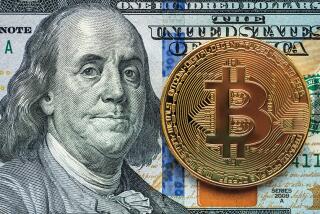INVESTING
- Share via
Precious metals are living up to their moniker this year: While Wall Street struggles, prices of gold, silver and platinum have surged to their highest levels since at least September.
After tumbling along with stocks and virtually every other asset in the fall market meltdown, the metals once again are playing the role of havens: Investors’ jitters about the state of the global economy and financial system are driving some to buy gold, silver or platinum as a hiding place.
“You’ve got the flight to quality going on,” said Matt Zeman, a trader at LaSalle Futures Group in Chicago.
The metals scored big gains Tuesday and Wednesday in part on Wall Street’s disappointment over the U.S. Treasury’s apparent lack of progress in devising Phase 2 of the financial-system rescue.
Gold futures rose again Thursday in New York, climbing $4.70 to $948.50 an ounce -- the highest price since July, and within sight of the $1,000-an-ounce threshold that was briefly breached last winter.
The SPDR Gold Trust exchange-traded mutual fund, which invests in gold bullion and so tracks the metal’s price moves, is up 7.7% this year, while the Standard & Poor’s 500 stock index is down 7.5%.
Silver futures edged down 1 cent to $13.50 an ounce Thursday after soaring 39 cents Wednesday to the highest price since late August.
Platinum slipped to $1,077.90 an ounce, off $2.80 from a five-month high set Wednesday.
With Congress set to pass a fiscal-stimulus bill worth $789 billion, some investors worry that heavy government spending -- along with rock-bottom short-term interest rates -- will stoke inflation down the road, which could undermine the dollar’s value.
So far, the dollar has held up this year. But if people lose faith in the paper currency, the natural beneficiaries could be the oldest currencies: gold and silver.
Many investors buying precious metals “don’t trust the government,” said Ralph Preston, a commodities analyst at brokerage Heritage West Futures in San Diego.
But that mistrust also is benefiting the government’s own sales of bullion. The U.S. Mint shipped 92,000 1-ounce gold American Eagle coins to its dealer network in January, up sharply from 22,500 in January 2008.
Government mints worldwide “are producing as fast as they can to meet demand,” said Ken Edwards, a partner at gold dealer California Numismatics in Inglewood. “And we’re selling it as fast as we can pull it in.”
Still, Edwards cautioned that, in the short term, prices of precious metals always are at the mercy of speculators in the futures markets. Dumping of futures contracts by desperate hedge funds and other investors last fall slammed gold from $909 an ounce in late September to $705 by mid-November -- even as demand for gold coins remained robust.
Silver dived from $19.25 an ounce in mid-July to $8.79 by late October, a drop of 54%.
“The people playing short-term moves [in futures] have much more power over the market than the guy buying 3 ounces of gold,” Edwards said.
That was evident almost a year ago, when gold capped a six-year advance by peaking at a record $1,004.30 an ounce March 18. The market then lost its momentum, even as prices of many other commodities, including oil, continued to surge until early in summer.
As the $1,000 price mark looms again for gold, bullish traders are hoping for a decisive advance through that level -- a thrust that would be sure to grab the attention of a public starved for investment winners.
It was just a year ago that gold topped the $850 mark, which was where the price had peaked amid the inflation hysteria of 1979-80. The metal then mostly sank through the 1980s and 1990s as inflation waned, falling as low as $254 an ounce by July 1999.
--
More to Read
Inside the business of entertainment
The Wide Shot brings you news, analysis and insights on everything from streaming wars to production — and what it all means for the future.
You may occasionally receive promotional content from the Los Angeles Times.










